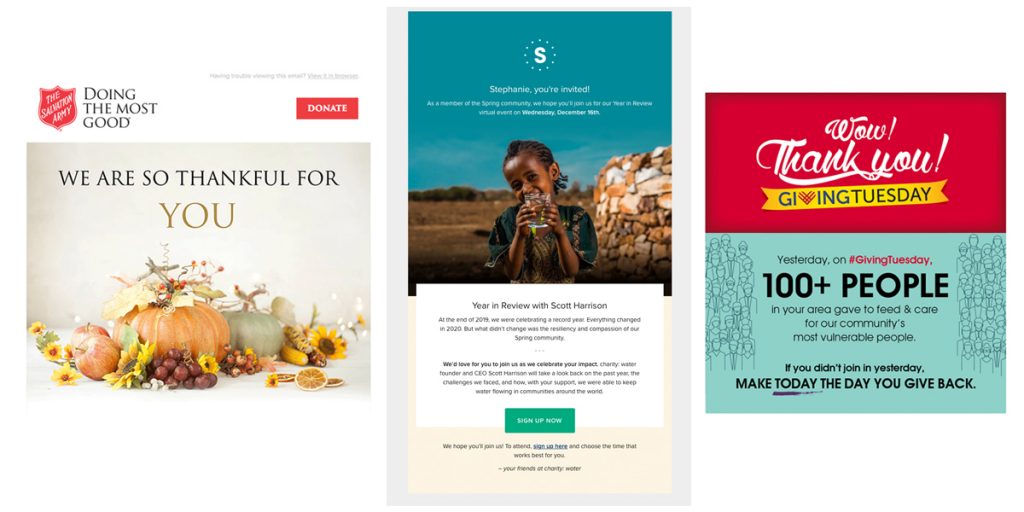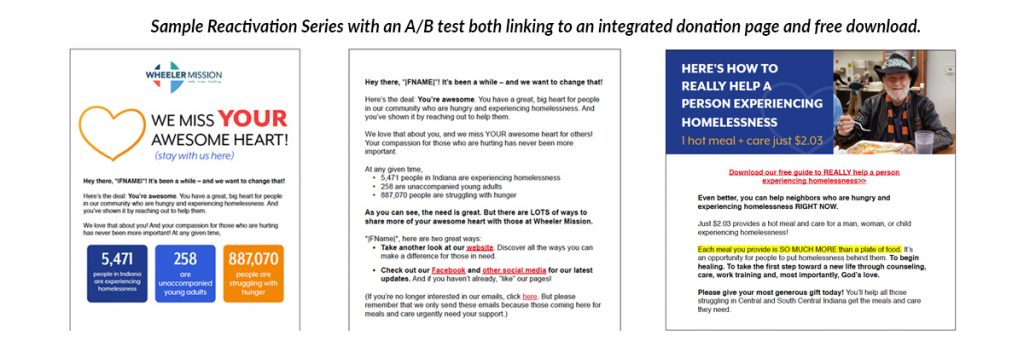“Are we sending too many emails?”
This is a question our digital team gets asked a lot. And honestly, we DO send a lot of fundraising emails on behalf of our clients, especially between September and December! So as you enter the 1st quarter of 2021, you may be wondering if your donors are experiencing any sort of email fatigue.
At the start of a new year – and especially another uncertain year – nonprofits need to be communicating with their donors on a regular basis. But because of the way email stacks up in November and December, I get why nonprofits get sensitive about how many asks they’re sending at this time of year.
So are you sending too much email? There are lots of ways to answer this question, which I’ll dig into in a minute, but here’s my short answer: No. You’re NOT sending too many emails, I promise!
Just be sure your email marketing program includes these 5 important steps:
1. Send your email subscribers relevant and varied content
As a fundraiser, it’s my job to create fundraising emails that will generate revenue. But fundraising emails should only be a portion of the email content your donor receives. According to the 2020 M+R Benchmarks Study, nonprofits sent an average of 50 email messages per subscriber in 2019. On average, fundraising appeals accounted for 22 of these messages, newsletters for 11 and advocacy messages, 7.* Add additional non-fundraising communications into your mix throughout the year including: thank you messages, organization updates, testimony/success stories, event invitations and advocacy messages.

2. Use list segmentation and timing
Most of the fundraising emails that we send for our clients have scheduled resends with specific list segment requirements. A great example of this is resending the original email to a subscriber who didn’t open it the first time around. While it may feel like you’re emailing the same email to the donor again, you’re not.☺ The more a list can be segmented to send personalized and targeted emails, the better. Use a marketing automation platform like Salesforce, HubSpot or Virtuous (to name a few) – it’s the ultimate way to manage your donor communications and feel good about exactly when and how many emails are going out in a given time period.
3. Conduct good list hygiene
Check your email list semi-annually and remove any people that haven’t responded to your emails. Our BDI team has determined a recency and frequency that makes sense for our clients and typically remove 30% of the file to an inactive segment. Then get creative with a reactivation email to these folks, inviting them to reengage with you. This helps maintain higher delivery rates to your active file, and stops you from emailing folks who either aren’t interested or don’t want to engage with you via email – which will help you feel confident that the emails you’re sending out will be welcome by the recipients.

4. Reply to any email responses to your email campaigns
During the busy 4th Quarter fundraising season, you may receive a few emails from donors who express concern at receiving too many emails, or hear from a donor who already gave to a previous email they received. My advice: respond quickly, acknowledging their concern and thanking them for their support.
Pro Tip: Create a “from” email address specific for your email marketing program. I like creating an email that’s very close to the one you’d get from a friend or colleague. As an example: You could use Joe D. Brown, OrganizationName.com – or even Joe Brown, OrganizationName.com. It feels genuine! An added benefit is that this email can be replied to, so your team can check and personally respond when donors reply with questions or concerns.
5. Watch the results
Another important way to measure your success and to determine if there’s any donor fatigue in terms of receiving too many fundraising emails is monitoring key performance indicators (KPIs) on any campaign, such as:
- Open rate
- Click-through rate
- Conversion rate
- Unsubscribe rate
- Delivery rate
Unsubscribes and list attrition is going to happen. It’s why you also need to have list building strategies throughout the year. As long as the key measurements stay within a healthy range, then the extra emails that get sent in the fall are only benefiting your organization by raising the additional revenue needed to support your organization’s goals.
Want to discuss the specifics of your email marketing program? Feel free to email me directly at stippitt@bdiagency.com. I would love to hear from you!
You need to read this! Click here to read “Leading the Charge in 2021” from BDI’s CEO and President, Michael J. Tomlinson.




